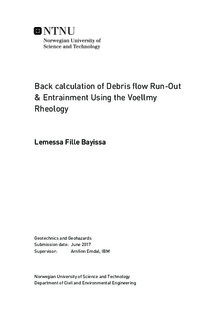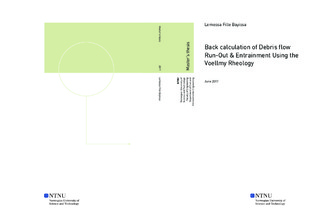| dc.description.abstract | Debris flow is one of the many geo-hazards that cause a major damage worldwide. It can cause loss of human lives especially to those living in mountainous regions. Besides, it cause economic damage by destroying properties and infrastructure. Forecasting and controlling the hazard associated to this type of mass movements is still a difficult task that requires qualitative and quantitative analyses. However, the development of numerical dynamic run out models has a major advantage in the study of this processes, as they allow the simulation of possible future scenarios. Some of these numerical models currently in use for simulating debris flows are MassMov2D, DAN-3D, FLO-2D and RAMMS.
The main objective of this thesis was to back calculate debris flow run out and its entrainment behavior using numerical models. For this study, the Author uses RAMMS run out model for the back analysis of debris flow mobility. RAMMS is able to model entrainment along the flow path by using rate controlled entrainment method, which regulates the amount of mass being entrained in to the debris flow and the time needed to accelerate this mass to the debris flow velocity.
One Norwegian debris flow, Mjåland debris flow happened in June 2016, was back calculated using RAMMS. The Voellmy rheological model was used first to calibrate the input parameters (friction coefficient, turbulence factor and entrainment coefficient) and then to test the sensitivity of each parameter. The model is found to be highly sensitive to entrainment coefficient, K, friction coefficient, µ and turbulent friction, ξ.
The result of this study also showed that the velocity and height of the flow with entrainment and slope is relatively greater than the normal range for debris flow. Although RAMMS was able to simulate entrainment, the quality of its output depends on the resolution of digital elevation model (DEM) used as input during modelling. | |

